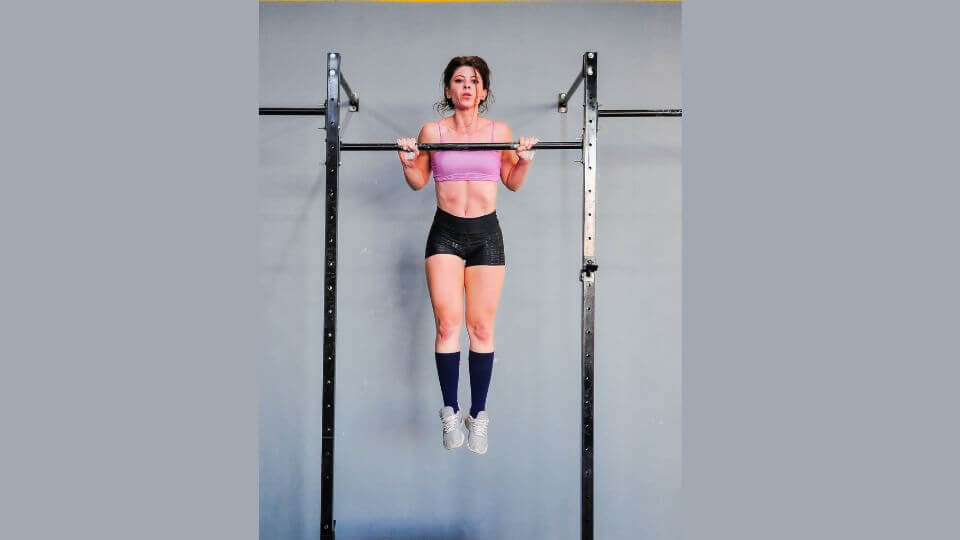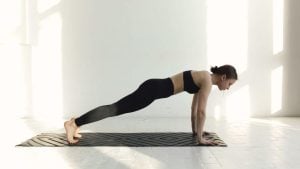Before you dive into the article, I wanted to pin this pull-up workout plan here, which you can explore once you feel ready to work on your pulling strength!
Workout Plan: From 0 to 5 Pull-Ups in 6 Weeks

- Best program if you can't do a pull-up yet
- Designed to improve your pulling strength
- Specifically targeted to develop the back muscles, biceps and rear deltoids
- Includes 2 workouts per week (12 total)
- Each workout is 45 minutes long
- Each workout has a warm-up, strength, and HIIT part
Pull-up progression basics: The road to your first pull-up
Pull-ups are one of the most essential calisthenics exercises. In terms of equipment, all you need is a pull-up bar or a pair of gymnastics rings. If you have no calisthenics equipment yet, make sure to check out the best back exercises you can train without a pull-up bar.
In terms of strength, the biggest limiting factor for most people is their grip, mainly the weak forearm muscles - they are not able to hold their own weight while hanging from the bar. Another area that you need to target is your upper back strength.
In order to be able to achieve a strict pull up you need to build the foundational grip and scapular strength by practicing the exercises from the pull-up progression chart:
- Dead Hang: It’s an isometric movement that involves you hanging from a pull-up bar while your arms are fully extended. This exercise will help you improve your grip strength.
- Active and Passive Hang: Retract and protract your shoulder blades while hanging from a pull up bar. Keep your arms fully extended and close to your ears. Your head should move in a straight line up, between your arms.
- Scapular Wall Slides: Stand facing a wall with your arms extended straight in front of you at shoulder height. Place your palms on the wall, and slide your arms up the wall while keeping your shoulder blades squeezed together. Slowly lower your arms back down to the starting position and repeat.
- Scapular Pull-Ups: This exercise helps to activate and strengthen the muscles in your shoulder blade. Start in a dead hang position, and then pull your shoulder blades down and together without bending your elbows. Hold for a few seconds, and then release.
- Scapular Push-Ups: Start in a push-up position, and lower your body down toward the ground while protracting your shoulder blades (pushing them away from your spine). Push back up into the starting position, and then retract your shoulder blades (pulling them back towards your spine). Don’t bend your elbows and keep your core engaged to maintain a straight body. Repeat the push-up, alternating between protraction and retraction.
- Scapular Dips: Grab onto the edge of a sturdy surface, such as parallel bars or a countertop, with your feet extended out in front of you. Lower your body down while protracting your shoulder blades, and then push back up while retracting your shoulder blades. Again, it’s important not to bend your elbows. Keep alternating between protraction and retraction.
- Face Pulls: Attach a resistance band to a pull-up bar or other sturdy surface at chest height. Hold onto the band with both hands and take a few steps back to create tension. Pull the band towards your face, keeping your elbows up and squeezing your shoulder blades together. Slowly release the band back to the starting position and repeat.
The exercises above will serve you well even after you are able to do a few pull ups. You can incorporate them into your warm-up or accessory work to target weaknesses.
Progress from one pull-up to more
After your first pull up the work is still not done - it is just beginning. Once you are able to do a strict pull-up with a full range of motion it’s time to go to slightly more challenging exercises.
- Isometric or Static Holds: Hold yourself in various positions of the pull-up, such as at the halfway point or at the top, for as long as you can. This will help build strength in the muscles used for the pull-up.
- Eccentric or Negative Pull Ups: Negatives are when you focus on the lowering portion of the pull-up. Start at the top of the pull-up position and slowly lower yourself down to the bottom position. You can do it by using a box or jumping into the top pull-up position.
- Assisted Pull-Ups: Use a resistance band or have a partner assist you with the pull-up movement. You can gradually decrease the amount of assistance as you get stronger by switching to a thinner band.
- Jumping Pull-Ups: Start with your feet on the ground or on a box. Use a slight jump to assist your arms as you pull yourself up to the bar at chest height. Focus on holding yourself to the bar for 1-2 seconds and lowering your body as slowly as possible.
- Chin-Ups: Chin-ups are similar to pull-ups but with an underhand grip. This can help target the biceps and scapular muscles. You can use this exercise interchangeably with the pull-up.
- Inverted Rows: This exercise targets the same muscles as pull-ups but in a horizontal position. Lie under a bar or a sturdy table, and pull your body up towards the bar or table.
- Assisted Front Lever: Hook a resistance band on the pull up bar and step into it. Raise your legs into an L-sit and elevate your hip into a front lever position. Maintain a straight arm and body while your feet are being supported by the band. Hold for as long as you can and slowly lower yourself afterward. This will target your lats.
6-week calisthenics workout routine for improved pull strength

Week 1-2:
Workout 1:
- Scapular Wall Slides: 3 sets of 10 reps
- Bodyweight Rows: 3 sets of 10 reps
- Eccentric Pull Ups: 3 sets of 3 reps
Workout 2:
- Scapular Push Ups: 3 sets of 10 reps
- Resistance Band Rows: 3 sets of 10 reps
- Isometric Hold at the Top of the Pull-Up: 3 sets of 5-10 seconds
Workout 3:
- Scapular Dips: 3 sets of 10 reps
- Face Pulls: 3 sets of 10 reps
- Eccentric Pull Ups: 3 sets of 3 reps
Week 3-4
Workout 1:
- Scapular Wall Slides: 3 sets of 12 reps
- Bodyweight Rows: 3 sets of 12 reps
- Eccentric Pull Ups: 3 sets of 4 reps
Workout 2:
- Scapular Push Ups: 3 sets of 12 reps
- Resistance Band Rows: 3 sets of 12 reps
- Isometric Hold at the Top of the Pull-Up: 3 sets of 10-15 seconds
Workout 3:
- Scapular Dips: 3 sets of 12 reps
- Face Pulls: 3 sets of 12 reps
- Eccentric Pull Ups: 3 sets of 4 reps
Week 5-6
Workout 1:
- Scapular Wall Slides: 3 sets of 15 reps
- Bodyweight Rows: 3 sets of 15 reps
- Pull Up Negatives: 3 sets of 3 reps
Workout 2:
- Scapular Push Ups: 3 sets of 15 reps
- Resistance Band Rows: 3 sets of 15 reps
- Pull Up Isometric Holds: 3 sets of 10-15 seconds
Workout 3:
- Scapular Dips: 3 sets of 15 reps
- Face Pulls: 3 sets of 15 reps
- Pull Up Negatives: 3 sets of 3 reps
Perform each workout 3 times per week, with at least one day of rest in between. Gradually increase the resistance or difficulty of each exercise as you get stronger. Keep track of your progress and increase the number of reps or sets as you go. Once every two weeks attempt to do as many pull ups as possible.
How to mount a resistance band at home
Having access to a pull up bar is non-negotiable for calisthenics. You can find a calisthenics park near you, go to a gym or mount a bar at home.
The other equipment that you will need is a set of resistance bands with different thicknesses that can help you build strength and assist you with your pull up practice.
You can mount a resistance band at home on the:
- Doorway: You can loop the resistance band around the top of a door using a hook and then close the door to hold it in place. Make sure the door is secure and won't open during your workout.
- Pull Up Bar: You can loop the resistance band around a pull-up bar and then step on it to begin exercising.
- Wall or Ceiling Mount: You can mount a hook or anchor to a wall or ceiling and then attach the resistance band to it. Make sure the hook or anchor is strong enough to support the load.
- Furniture: You can loop the resistance band around a sturdy piece of furniture, such as a couch or table, and then step on the band to secure it in place. Make sure the furniture is stable and won't move during your workout.




